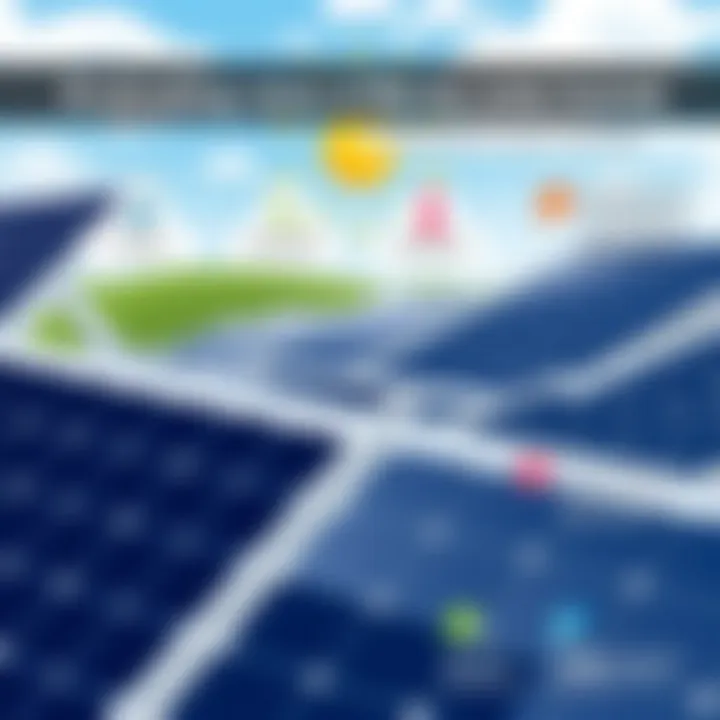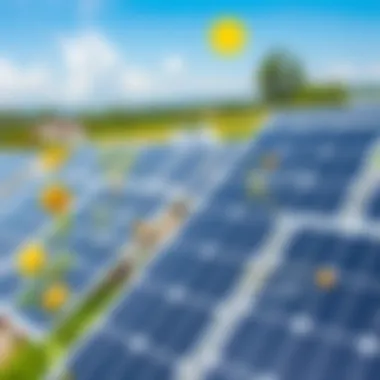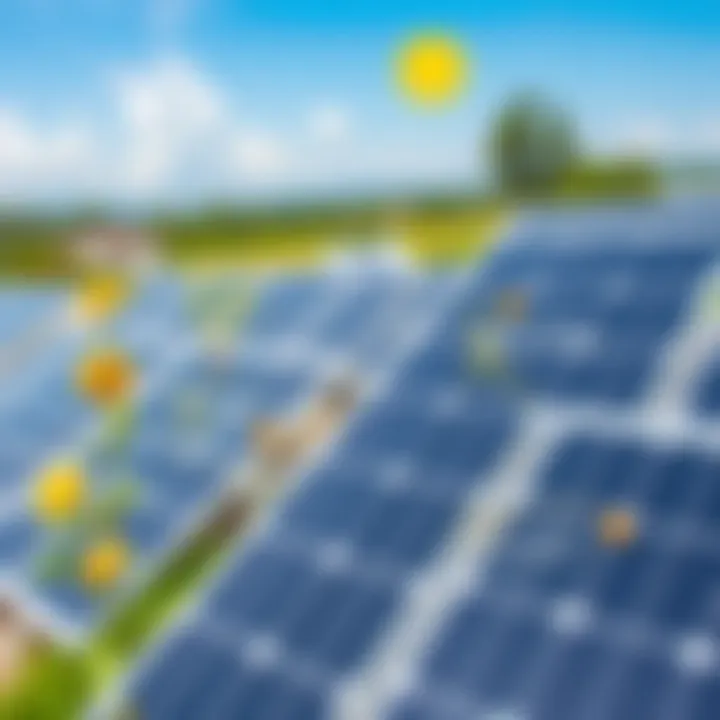Evaluating Value for Money in Solar Panels


Intro
In an age where renewable energy is taking center stage, solar panels have emerged as a prominent option for those looking to harness the power of the sun. The promise of energy independence and potential savings on electricity bills is tempting, but diving into the world of solar can be puzzling. With various products flooding the market, it's crucial to sift through these options to identify those that truly offer bang for your buck. Understanding solar panels isn't just about technology; it's about navigating the financial aspects, which is where our discussion of value comes into play.
While many see solar panels as a mere installation, they represent an investment that can yield long-term financial benefits. However, evaluating which panels will deliver the best return on investment requires an understanding of crucial factors such as performance metrics, cost implications, and government incentives. Each component plays its part in the larger equation of solar panel value, and by arming yourself with knowledge, you’ll be better prepared to make informed decisions about your energy future.
Throughout this article, we’ll shed light on the essential aspects of evaluating the best solar options tailored to your specific needs and budget. From understanding key financial lingo to diving into brand comparisons, this narrative aims to guide you step by step on your journey to a greener and more financially sound investment. Let’s begin by exploring some relevant financial terms that will empower you to navigate the complexities of solar panel investments.
Intro to Solar Power
Solar power stands at the forefront of the contemporary energy conversation, shaping our approach to sustainability and environmental responsibility. This article delves into the nuances of solar energy and the range of solar panels available on the market, focusing on their value for money. The importance of understanding solar power extends beyond mere financial decisions; it also influences how we perceive energy consumption and our role in combating climate change.
Understanding Solar Energy
At the core of solar power is the ability to convert sunlight into energy, a process that harnesses one of the most abundant resources on our planet. Solar panels, composed primarily of photovoltaic cells, absorb photons from sunlight and convert them into electricity. This transformation not only provides a source of renewable energy but also contributes to a significant reduction in greenhouse gas emissions. In an era when climate change looms large, tapping into solar energy offers a lifeline for individuals and businesses seeking sustainable solutions.
Moreover, the implications of adopting solar energy stretch into both economic and environmental realms. As energy bills continue to escalate, the prospect of lowering these costs through solar panels becomes increasingly appealing to homeowners and enterprises alike. Additionally, understanding solar energy empowers stakeholders to engage more meaningfully in conversations about energy policy and sustainable practices.
The Rise in Popularity of Solar Panels
The popularity of solar panels has surged over the past decade, fueled by advancements in technology, increasing awareness of environmental issues, and favorable government policies. Even cities that were skeptical just a few years ago are now embracing solar energy, as it offers a dual benefit of lowering energy costs while enhancing sustainability records.
In regions like California and Germany, solar panels have proliferated, becoming synonymous with modern living. The decreasing cost of installation and improvements in efficiency ratings have made them accessible to a broader demographic. Homeowners are no longer solely motivated by a desire to save money; they are also driven by an ethical imperative to foster a sustainable future.
In addition, community solar projects have emerged, allowing those without access to their own roof space to participate in the solar revolution. This shift creates a sense of shared responsibility and collective action; it’s a trend that underscores how consumer behavior can catalyze major change in energy paradigms. Evaluating these dynamics will be central to our discussion about finding the best value solar panels, and how they align with both financial prudence and environmental accountability.
What Constitutes Value for Money in Solar Panels
Understanding what constitutes value for money in solar panels is fundamental to making an informed investment in solar energy. The phrase 'value for money' goes beyond just looking at the sticker price. It encompasses factors such as performance, installation costs, longevity, and maintenance, all of which contribute to the overall effectiveness of your solar system.
By grasping the nuances of these elements, one can better assess different options available in the market, avoiding potential pitfalls that could lead to spending more than necessary without receiving adequate returns.
Evaluating solar panels involves dissecting two main aspects: performance metrics and financial implications through cost considerations. Together, they help paint a clearer picture of how to gauge the worth of solar panels effectively.
Performance Metrics
Energy Efficiency
Energy efficiency is one of the cornerstones of understanding solar panel value. This aspect refers to how much sunlight a panel can convert into usable electricity. Higher energy efficiency means more power produced for the same amount of sunlight, translating into better returns on your investment.
One key characteristic of energy efficiency is its standard measurement, often expressed as a percentage. Solar panels with efficiency ratings above 20% are considered top-tier. This makes them a popular choice for residential and commercial installations alike, primarily because they maximize energy production in limited spaces.
A unique feature of energy efficiency is that it can vary by manufacturer and technology type. Higher efficiency panels can sometimes carry a higher price tag. However, the long-term savings they provide in energy bills often warrants this investment, turning what seems like a higher cost into a viable financial decision.
Power Output
Power output reflects the actual amount of electricity a solar panel can generate, typically quantified in watts. This metric contributes significantly to understanding the overall energy generation capability of a solar installation.
Highlighting this aspect, one characteristic of power output is how it correlates with the size of the solar array. Larger systems generally yield higher outputs, which can be beneficial for larger households or businesses needing more energy.
However, there’s a unique aspect to consider; not all solar panels are designed to work equally well under all environmental conditions. Some might excel in low light or cloudy weather, whereas others show peak efficiency on sunny days. Choosing panels with a suitable power output for your location can profoundly impact your energy generation, thus influencing the perceived value of your investment.
Durability
Durability is another critical metric in assessing solar panel value. This refers to the lifespan and resistance of the panels to environmental factors, such as hail, wind, and temperature extremes. A panel that can withstand these conditions without significant degradation provides true value over time.
One of the key characteristics of durable solar panels is their materials; high-quality glass and robust frames tend to enhance longevity. Many reputable manufacturers offer warranties lasting 25 years, indicating their confidence in their product's durability.
The unique feature of durability is that it not only reduces potential replacement costs but also assures that the panels will perform consistently over their lifetime. Investing in durable solar panels can save you from unnecessary maintenance and replacements, which is a significant consideration when evaluating total long-term costs.
Cost Considerations
Initial Investment
The initial investment is often the first aspect considered by potential solar buyers. This figure includes the purchase price of the solar panels, installation costs, and any additional equipment needed, like inverters. Having a clear understanding of the initial investment required helps in budgeting your solar project effectively.
A key aspect here is that while lower upfront costs can be attractive, they may lead to trade-offs in terms of efficiency or warranty. Therefore, it is advisable to balance initial costs against the potential benefits and savings over time.
Long-term Savings
When considering solar panels, long-term savings are crucial to evaluate the real value of your investment. This metric accounts for the reductions in electricity bills, as well as potential earnings from selling surplus energy back to the grid in some regions.
The characteristic of long-term savings highlights that while initial costs can be daunting, the reduction of electricity expenses accrued over years can lead to significant financial benefits.
A unique aspect is how regional energy prices affect these savings. In areas with higher energy rates, the financial perks of solar can be considerably greater, making the investment more worthwhile even if the initial price seems steep.
Return on Investment


The return on investment (ROI) of solar panels offers a quantifiable measure of financial effectiveness by expressing the ratio of gains from the investment compared to its costs.
One key characteristic to keep in mind is that a higher ROI means your solar investment pays off quicker, making it an appealing measure for those seriously considering solar. Your ROI could vary significantly based on factors such as energy consumption patterns, geographic location, and available incentives.
The unique angle of ROI lies in how it can be calculated over different time frames. Whether you view your investment in terms of years or decades can significantly adjust how attractive the value for money is perceived. Understanding your potential ROI can guide you in choosing the right solar solution tailored to your needs and preferences.
Key Factors Influencing Solar Panel Prices
When exploring solar energy options, understanding the factors that drive solar panel prices is crucial for getting the best bang for your buck. There are numerous elements at play that can significantly influence costs. From material types to brand reputation, each factor contributes to the overall price and value of solar panels available on the market today.
Material Composition
Material composition is a fundamental element that not only affects the cost of solar panels but also their efficiency and longevity. The main types of materials used in solar panels are monocrystalline, polycrystalline, and thin-film technologies, each having distinct characteristics.
Monocrystalline vs. Polycrystalline
Monocrystalline panels are crafted from a single crystal structure, resulting in high efficiency and space efficiency. This means they produce more electricity per square foot than their polycrystalline counterparts. The lustrous black appearance of monocrystalline panels is often viewed as a mark of quality, making them the premium choice in many situations. Their longevity is another strong suit, typically lasting longer than polycrystalline panels and often coming with 25-year warranties.
On the other hand, polycrystalline panels are made from multiple crystal structures which can lower their efficiency compared to monocrystalline options. They are generally less expensive to produce, which can make them more attractive for budget-conscious buyers. However, since they tend to occupy more space to produce the same output as monocrystalline panels, their installation might not always be practical in areas where space is limited.
In short, while monocrystalline may be the popular choice, polycrystalline still holds its own in being a cost-efficient alternative for many.
Thin-Film Technology
Thin-film technology represents another divergent path in solar panel production. These panels are created by depositing a thin layer of photovoltaic material on a substrate. Their lightweight and flexible design make them exceptionally versatile, allowing for integration into a variety of surfaces, such as rooftops and building facades. Thin-film panels are typically less efficient than crystalline panels, but they can perform better in high temperatures and shaded areas, which can be beneficial depending on your environment.
While they often come at a lower initial cost, their overall lifespan tends to be shorter, which means potential long-term financial implications for buyers who may need to replace them sooner than expected. Therefore, although thin-film has its merits, careful consideration of a buyer's specific circumstances is essential.
Brand Reputation
Brand reputation plays a significant role in determining solar panel prices. Established brands with a long track record often command higher prices due to perceived reliability and quality. Consumers might be willing to pay a premium for brands known for their superior warranties, robust customer service, and consistent performance. These forces create a level of trust that can be invaluable when making such a significant purchase. Conversely, newer or less known brands may offer competitive pricing but could lack the same level of assurance regarding their product's performance and longevity.
Market Trends and Demand
Market trends and demand are also crucial factors influencing solar panel pricing. In recent years, especially with global awareness about climate change surging, the demand for solar energy solutions has escalated. Broader acceptance can drive up prices as more consumers look to invest in renewable energy. Government incentives, like tax rebates and credits, also play a role in market demand; as these incentives increase, so too does consumer interest in solar products. Thus, understanding the ebb and flow of both demand and governmental support can provide valuable insight into the best time to invest.
Comparative Analysis of Leading Solar Panel Brands
In the expansive world of solar energy, knowing which companies stand out can make all the difference in choosing panels that not only fit your budget but also meet your energy needs. A comparative analysis of leading solar panel brands serves as a compass, guiding both new and seasoned solar enthusiasts through the sea of options. Understanding the strengths and weaknesses of each brand equips consumers with the necessary insights to make informed decisions.
An effective breakdown accentuates how certain brands excel in energy efficiency, warranty provisions, or durability over others. This deep dive isn't solely about perusing specs; it's about aligning your personal energy goals with the strengths of each brand.
Top Brands Overview
In the competitive landscape of solar panels, a few names frequently emerge as front-runners. Companies like SunPower, Canadian Solar, and LG continually garner attention for their product offerings, each with unique benefits and shortcomings. An overview of these brands reveals patterns in innovation, customer service, and after-sale support that can influence a buyer's decision.
Strengths and Weaknesses
Brand A Analysis
SunPower is widely recognized for its high energy efficiency rates, often ranking at the top of performance metrics. Their panels feature an impressive warranty of 25 years, which speaks volumes about their confidence in product longevity. However, these superior offerings come with a higher initial price tag, potentially deterring budget-conscious consumers.
The standout feature of SunPower panels lies in their patented Maxeon solar cell technology, which enhances energy output and minimizes degradation over time. While this advantage supports long-term savings on energy bills, the upfront cost could be a stumbling block for some buyers.
Brand B Analysis
Canadian Solar blends affordability with accessibility, making them a popular choice among homeowners. Their panels generally provide decent energy efficiency while presenting a more manageable price point, creating a solid entry-level offering for first-time buyers.
A notable attribute of Canadian Solar is the wide variety of panels catering to different needs. Still, potential customers need to weigh the lesser warranty period compared to other brands. They deliver value, primarily for consumers on a budget, but might not offer the same durability as higher-end models.
Brand Analysis
LG counts itself among the giants by equipping its solar panels with the latest technology, often aiming for higher performance and efficiency. They boast a reliable warranty process and are known for excellent customer service after installation. On the flip side, LG panels can fall on the pricier side as well, pushing some consumers to reconsider their options.
One key aspect that distinguishes LG is their commitment to aesthetics, resulting in sleek, modern designs that blend well with residential rooftops. While their high quality adds to value, that same quality comes with a higher cost, which may leave some consumers pondering their priorities.
In summation, the choice between brands like SunPower, Canadian Solar, and LG hinges on individual priorities—be it upfront costs, warranty length, or panel efficiency. Beyond just price and features, considering the complete package including long-term performance and customer service can lead to a more informed selection process. As the landscape for solar technology continues to evolve, periodic checks for industry trends can greatly enhance the decision-making journey.
Evaluating Solar Panel Efficiency Ratings
In the quest for sustainable energy solutions, evaluating solar panel efficiency ratings becomes a central focus. Efficiency ratings provide insights into how well a solar panel converts sunlight into usable electricity, an essential metric for investors who wish to optimize their investments. With the myriad of options flooding the market, understanding these ratings allows consumers to make informed decisions on which product offers the best value for their dollar.
The significance of efficiency ratings cannot be overstated. Higher efficiency ratings often lead to greater overall energy production, meaning less space is needed for installation. For homeowners, this translates into reduced roof space being taken up by panels, especially if the property has limited area for deployment. Investors likewise gravitate towards high-efficiency models to maximize return on investment, ensuring energy needs are met without excessive equipment outlay.
Understanding Efficiency Ratings
Solar panel efficiency is essentially a percentage that reflects how much of the sunlight hitting the panels is converted into electrical energy. For instance, a solar panel with an efficiency rating of 20% can transform one-fifth of the sunlight to electricity. The efficiency of panels varies widely, with some of the top-tier products reaching ratings over 22%.
To put things in perspective, consider the following factors that influence these ratings:


- Material Quality: The type of silicon used dramatically affects efficiency. Monocrystalline panels typically edge out their polycrystalline counterparts in performance, offering more energy production during the same daylight hours.
- Technology Advances: Newer technologies, including bifacial panels and PERC technology, are advancing the frontier of efficiency, providing more bang for your buck.
- Temperature Coefficient: This rating gives insight into how well a panel performs in high temperatures, which can affect overall efficiency during the sweltering summer months.
Understanding these ratings helps potential buyers gauge the performance difference among options available in the market.
Impact on Energy Production
The implications of efficiency ratings are profound when it comes to energy production. Higher-rated panels generate quantum leaps more power when compared to lower-rated alternatives. For instance, if you have a roof that can hold six panels, investing in six 20% efficient panels could yield up to 75% more energy than six 15% efficient panels over time.
- Economical Footprint: High-efficiency panels allow homeowners to utilize less square footage. This is particularly crucial for urban areas where roof space is a premium. A few extra percent in efficiency can make the difference between adequately powering your home and having to rely on grid energy.
- Energy Independence: When efficiency is maximized, homeowners can reach a higher degree of energy independence. Self-sustaining energy production isn’t just a boon for personal finances, but also contributes positively to the environment.
"In real estate, it's all about location, location, location. In solar energy, it's efficiency, efficiency, efficiency."
Overall, as renewable energy becomes an increasingly urgent matter, keeping efficiency ratings as a critical component of your solar panel assessment can propel investments from merely adequate to truly exceptional.
Installation Costs and Considerations
Installation costs are a significant factor when it comes to evaluating the value for money of solar panels. The upfront expenses can often feel like a hefty weight on your shoulders. However, understanding what contributes to these costs can empower you to make smarter choices. In this section, we explore the elements that affect installation pricing and how selecting the right installer plays a pivotal role in ensuring a quality installation—one that maximizes the benefits of your solar investment.
Factors Affecting Installation Pricing
When evaluating the installation costs of solar panels, several elements come into play:
- System Size: Larger systems naturally incur higher installation costs. The more panels you install, the more labor, equipment, and time are required.
- Roof Type and Accessibility: A roof's design can significantly influence installation complexity. Steep, slate, or tile roofs might present unique challenges, leading to increased labor costs. Also, if your roof is difficult to access, it might necessitate extra safety measures.
- Location: Installation costs vary by region due to differences in labor rates, local regulations, and permitting expenses. Your area’s climate may also dictate specific types of systems that are more effective.
- Wiring and Hardware: The need for additional wiring, inverters, and mounting equipment also impacts costs. Innovative technologies may promise more efficiency but can also come with a heftier price tag.
- Permits and Inspections: Navigating local regulations can sometimes be a tricky business. Permit fees and inspections can add to the final costs. Understanding these can prevent any surprises during your installation.
Key Point: Recognizing these factors enables prospective buyers to accurately gauge whether a specific installation price offers true value for their investment.
Selecting the Right Installer
Choosing the right installer can mean the difference between an effort that dazzles and one that disappoints. Here are some insights to consider in your selection process:
- Experience and Reputation: Look for installers with a solid track record. Recommendations from previous customers can offer invaluable insights. A well-reputed installer not only assures quality but may also offer warranties on installation services.
- Certifications and Licenses: Ensure that the installer holds the necessary qualifications, which might vary by state. For instance, certifications from organizations like the North American Board of Certified Energy Practitioners (NABCEP) show that the installer has met specific industry standards.
- Pricing Structures: Compare different quotes. Pay attention to what’s included in the costs. Some installers might offer packages that appear cheaper but could cut corners, leading to future expenses.
- After-Sales Support: A responsive installer who provides maintenance and troubleshooting services in case issues arise down the road can save you a major headache.
- Customization Options: A good installer takes the time to assess your individual needs. They should be able to design a system that fits your specific requirements—not a one-size-fits-all solution.
Evaluating installation costs alongside choosing the right installer is integral to ensuring you receive maximum value from your solar panel investment. By being mindful of these considerations, you can pave your way towards a sustainable energy future without the clouds of uncertainty hanging overhead.
For more information on solar installation requirements, you might find this resource helpful to explore.
Government Incentives and Financing Options
In a world where energy independence and sustainability are becoming increasingly crucial, understanding the financial landscape surrounding solar power is essential. Government incentives and financing options play a pivotal role in the decision-making process for many buyers contemplating an investment in solar panels. The initial cost can be daunting, yet these financial aids can significantly lower the barrier of entry, making solar energy not just a dream but an attainable goal for a wider audience.
Tax credits, rebates, and various financing alternatives offer tangible benefits that can transform one's financial outlook. They allow shoppers to recoup a substantial portion of their investment, thereby accelerating the return on investment timeline. As we dive deeper into the distinct elements of government incentives, it's imperative to weigh their significance against the overall considerations in purchasing solar panels.
Tax Credits and Rebates
Tax credits and rebates are typically the first line of financial support that many homeowners or businesses consider when installing solar panels. These incentives are often granted by local, state, or federal governments to encourage the adoption of renewable energy technologies.
- Federal Solar Investment Tax Credit (ITC): One of the most notable incentives available is the federal investment tax credit, which allows consumers to deduct a significant percentage of their solar installation costs from their taxes. This can mean savings in the ballpark of thousands of dollars, depending on system size.
- State-Specific Programs: Numerous states offer additional credits and rebates, which can substantially increase savings. For instance, if someone lives in California, they might find specific programs aimed at promoting solar integration in residential areas, amplifying their potential savings.
However, it is crucial to stay informed about expiration dates and changes that may happen with these incentives, as they can shift and alter landscape quite rapidly.
"Investing in solar isn't just about saving on electricity bills; it can be a substantial financial decision influenced heavily by government backing."
Financing Alternatives
Financing options give prospective buyers flexibility in how they pay for their solar project. Let’s break down a few prominent methods:
Loans
When it comes to loans, they're a compelling and versatile option, especially with competitive interest rates available through various lenders. The beauty of solar loans lies in the fact that they allow customers to own their systems outright without having to pay the total upfront cost.
- Flexibility: Financing can offer extended repayment terms, allowing for lower monthly payments that closely align with expected savings on utility bills.
- Ownership and Benefits: Owners can take advantage of tax credits and rebates, making it an attractive option for those looking to invest in their energy future.
Yet, potential borrowers must read the fine print. Not all loans come with the same terms and conditions, so understanding fees and interest rates is integral to making a wise decision.
Leases
Leasing solar panels is another path many consumers take, and it can offer a way to go solar without the large upfront costs. In a solar lease agreement, an individual pays a fixed monthly amount to use the solar power system installed on their property—often with no down payment.
- Lower Upfront Costs: This can be particularly appealing for those who may not have enough cash flow to afford a full purchase.
- Maintenance Benefits: Generally, the leasing company maintains the system, further minimizing hassle for the homeowner.
However, it’s essential to factor in that lessees do not own the panels, thus losing access to tax credits, and may face charges if they wish to terminate the lease early.
Power Purchase Agreements
A Power Purchase Agreement (PPA) is somewhat of a hybrid between owning and leasing. Here, the homeowner agrees to purchase power generated from the solar system at a predetermined rate, which often undercuts local utility rate prices.
- No Upfront Costs: Much like leases, this agreement typically doesn’t require upfront costs, making it accessible for many.
- Pay for Power, Not Panels: The homeowner pays only for the energy produced, meaning they can still save without embarking on full ownership.


That said, clarity in terms is critical, as buyers must ensure that the long-term costs align with their energy usage patterns and future utility rates.
Maintenance and Long-term Considerations
When it comes to solar panels, many potential buyers focus primarily on the purchase price, efficiency, and even aesthetic appeal. However, overlooking maintenance and long-term considerations can be a costly misstep. It's crucial to understand that maintaining solar panels is not merely a chore; it significantly impacts their lifespan, efficiency, and ultimately, your return on investment. Just like a car needs regular check-ups to run smoothly, solar panels require consistent upkeep to reach their full potential.
Benefits of Regular Maintenance
Regular maintenance can prolong the lifespan of your solar panels while ensuring they operate at peak performance. Some key benefits include:
- Increased Efficiency: Dust, dirt, and debris can accumulate on solar panels, blocking sunlight and reducing energy output. Simple cleaning practices can mitigate this and keep your system performing optimally.
- Early Problem Detection: Routine inspections can catch small issues before they escalate. This proactive approach could save you hefty repair costs in the long run.
- Warranty Compliance: Many manufacturers stipulate that panels must be maintained according to their guidelines for the warranty to remain intact. Ignoring maintenance could void this vital safety net.
Overall, investing time and resources into maintenance ensures a sustainable energy source for years to come.
Routine Maintenance Practices
Practices that keep your solar panels in good shape may not be as daunting as they seem. Adopting a few straightforward habits can go a long way. Here are some essentials:
- Regular Cleaning
- Visual Inspections
- Monitoring Performance
- Depending on your location, it might be beneficial to wash your solar panels at least once or twice a year. The optimal time to clean them is early in the morning or late in the afternoon to minimize the chances of thermal shock. Use a damp sponge and a mild detergent to gently scrub off any dirt.
- Periodically check for any signs of wear and tear like cracked glass, loose wires, or corrosion. Conduct a visual inspection about every six months. If you notice anything out of the ordinary, consult a professional.
- Many modern solar systems come equipped with monitoring capabilities, allowing you to track energy production. Keep an eye on the output numbers. A sharp decline in energy production might indicate a problem that requires attention.
These practices don’t take much effort but are key in ensuring your solar panels remain effective.
Longevity of Solar Panels
Longevity is another critical aspect when considering the overall value of solar panels. Most quality panels come with a life expectancy of 25 years or more. Factors affecting their lifespan include:
- Quality of Materials: Higher-grade materials can withstand the elements better and thus offer a longer lifespan. For instance, monocrystalline panels, while initially more expensive, tend to outlast others.
- Local Weather Conditions: Depending on where you live, harsh weather such as hail, heavy snow, or strong winds can impact your panels' durability. Regions known for extreme conditions may require more robust systems.
- Installation Quality: A poorly installed system could suffer from structural issues down the line. Hiring qualified professionals ensures that everything is set up correctly.
"Investing in quality installation and maintenance practices can significantly bolster the longevity of your solar panel system."
Understanding these factors not only informs you about what to expect but also helps you set realistic goals for energy savings and planning.
In summary, maintaining your solar panels and considering their longevity are vital in making informed decisions regarding your investment in solar energy. Keep your panels clean, monitor their performance, and choose quality materials and installation methods. The dividends you reap will reflect the effort you put in.
Making an Informed Purchase
Making an informed purchase of solar panels is vital for those looking to leverage sustainable energy while also keeping an eye on their budget. With the plethora of options available in the market, one can easily feel overwhelmed. However, understanding what to look for would enable consumers to make decisions that not only reflect immediate needs but also align with future financial goals.
Researching Your Options
When it comes to researching solar panels, the goal is to gather as much relevant information as possible. This begins with understanding the differences among the types of panels available. Monocrystalline panels tend to offer higher efficiency but often come at a steeper price. On the other hand, polycrystalline options are generally more affordable but might not perform as impressively.
Key steps in researching:
- Identify Your Energy Needs: Before considering specific panels, assess your energy usage. Knowing how much power you consume on average will guide you in selecting the right size and number of panels.
- Consider Weather Variability: If you live in an area with frequent weather changes, look for panels that excel in low-light conditions. Efficiency ratings can vary based on this factor.
- Look at User Reviews and Testimonials: Don’t underestimate the voices of previous buyers. Perspectives from everyday users can offer insights that technical specifications often miss.
Deciding where to gather this information can make a world of difference. Websites dedicating themselves to solar energy articles, such as EnergySage or even governmental resources like Energy.gov, can provide valuable insights. Moreover, platforms like Reddit often have active discussions where enthusiasts share their experiences and recommendations.
Calculating Total Costs
Calculating the total costs associated with solar panels does not simply refer to the sticker price. Factors extend far beyond the initial investment; they encompass installation, maintenance costs, potential savings, and even financing options.
Elements to consider in total cost calculations:
- Initial Purchase Price: This is the starting point, representing the base price of the solar panels you choose. Don’t forget to factor in the installation costs here.
- Installation Expenses: Often, installation can significantly add to costs. Obtaining quotes from multiple contractors allows for comparisons and might unveil the best financial fit.
- Maintenance Costs: Although solar panels require minimal maintenance, over time, cleaning and any potential repairs can accumulate. Establishing a budget for these aspects is wise.
- Incentives and Rebates: Federal or state incentives can offset upfront costs, but it’s essential to confirm eligibility and understand timelines for these benefits.
- Long-term Savings Calculations: Estimate the savings on your monthly energy bill. This projection can help in determining the return on investment (ROI).
Ultimately, valuating total costs requires a thorough understanding of not just numbers but the bigger picture. By collating all this information, potential buyers will arrive at a more realistic view of what their investments will yield in the long run, ensuring they witness true value for money.
"An informed decision today can lead to significant savings tomorrow."
Culmination
In the landscape of solar energy, understanding how to assess the value of solar panels is paramount for anyone looking to make a wise investment. With the shift towards renewable energy sources, the decisions made today about solar panel selection can have significant consequences for both financial and environmental aspects down the line.
Summary of Key Insights
This article encapsulates several pivotal themes that contribute to finding the best value for money solar panels. First and foremost, performance metrics such as energy efficiency, power output, and durability play a crucial role in determining overall value. Efficient panels not only reduce energy bills but also offer longer lifespans and better performance in varying conditions.
Cost considerations also loom large. The initial outlay, projected savings, and the expected return on investment are essential elements to weigh in. Understanding these factors helps potential buyers to understand not just surface prices but the deeper implications of their investment over time.
Additionally, climbing installation costs and the importance of selecting a reputable installer cannot be overlooked. The decision process should factor in the quality and reliability of installers to ensure the system operates optimally.
Lastly, the relevance of government incentives and financing options was highlighted. These programs can make solar more accessible, allowing more individuals and businesses to benefit from solar energy’s long-term savings.
Final Recommendations
When considering the purchase of solar panels, several strategies can lead to smarter decisions:
- Conduct Thorough Research: Take time to research different brands and panels. Look at user reviews, professional ratings, and expert opinions to understand which models consistently perform well.
- Assess Total Costs: Beyond initial prices, calculate long-term costs and savings to get the full picture of your investment.
- Prioritize Efficiency Ratings: Invest in panels with higher efficiency ratings, as these can yield more energy output, maximizing your return.
- Choose Experienced Installers: Quality installation can impact a solar system's performance. Look for installers with proven track records and customer testimonials.
- Stay Updated on Incentives: Keep an eye on local government offerings. Funding and incentives for solar investments can vary greatly and might significantly affect your costs.
By analyzing these insights and implementing these recommendations, potential buyers can navigate the solar market effectively. A calculated approach ensures that investments in solar energy are not just beneficial in the short term but sustainable and lucrative in the long run.







